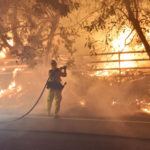Kansas legislators are modifying a proposal from Republican Gov. Sam Brownback’s administration to establish a fund to cover the state’s share of federally declared disasters.
Brownback wants to use $12 million from taxes collected each year on insurance premiums to establish what essentially would be a rainy day fund for disasters that cause extensive damage to infrastructure and property.
The goal is to avoid a repeat of last year, when lawmakers adjourned without financing $27 million the state owed for its share of disaster-related expenses, the bulk of which was owed to rural electric cooperatives.
Typically, federal funds cover 75 percent of disaster-related costs, local entities, including municipalities and nongovernment entities, pay 15 percent, and the state covers the final 10 percent.
Senators have proposed adding another $10 million per year to the disaster fund by tapping into fees the Kansas Universal Service Fund collects on wireless and land-line telecommunications. An additional fee would be charged on customers’ monthly bills to cover the expense, similar to how the state funds emergency communication services, such as 911 operations.
Senate Majority Leader Jay Emler said the administration seemed to be OK with expanding the fund.
“If you look at the 14 open disaster (cases) that we have, if that total amount comes due this next fiscal year, $12 million is a little over half of what we need,” said Emler, a Lindsborg Republican.
However, Sherriene Jones Sontag, the governor’s spokeswoman, said while Brownback appreciated the Senate’s support of his initiative, he would oppose raising fees to put more money in the fund.
“The governor believes his proposal of $12 million annually would allow the state to build up enough reserves in order to avoid or minimize future state general fund transfers or appropriations,” she said.
The fund would be capped at $40 million, with any interest earned on the account above that amount transferred to the Kansas Emergency Management and Homeland Security Fund of the adjutant general. The governor’s proposed budget allows for the reduction in insurance premium taxes but not an increase in the KUSF rate.
House Minority Leader Paul Davis said Brownback was right to set aside funds, noting that many Gulf Coast states such as Florida use similar means to cover disaster expenses.
“The state gets handed a bill to pay for them and it’s been a whopper lately,” said Davis, a Lawrence Democrat. “Trying to build that in the budget is a good thing.”
Kansas is prone to natural disasters, frequently getting struck by tornadoes, such as in Andover in 1991, Greensburg in 2007 and Reading in 2011, as well as last summer’s Missouri River flooding. It was pounded by ice and heavy snow in 2007.
Emler said the history of weather argues for setting aside ample funds.
“We always have another disaster,” he said. “Now, is it going to rise to the level of a FEMA disaster? Maybe not, but the $22 million would get us to the $40 million cap that’s in the bill a lot sooner.”
Topics Kansas
Was this article valuable?
Here are more articles you may enjoy.


 Three Charged With Helping Agents Cheat on Florida Insurance License Exams
Three Charged With Helping Agents Cheat on Florida Insurance License Exams  Coverage Needed: Hundreds of Thousands in SE Now in Flood Zones With New Maps
Coverage Needed: Hundreds of Thousands in SE Now in Flood Zones With New Maps  State Farm Seeking Large Rate Increases in Wildfire-Prone California
State Farm Seeking Large Rate Increases in Wildfire-Prone California  Changes at American Coastal Insurance After Florida OIR Action on ‘No-Fly List’
Changes at American Coastal Insurance After Florida OIR Action on ‘No-Fly List’ 

